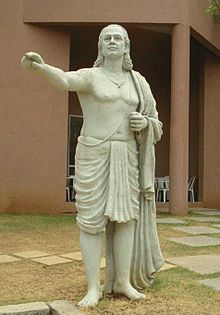Aryabhata
About me
|
Statue of Aryabhata on the grounds of IUCAA,Pune. As there is no known information regarding his appearance, any image of Aryabhata originates from an artist's conception. |
|
|
Born |
476 CE |
|---|---|
|
Died |
550 CE |
|
Era |
|
|
Region |
|
|
Main interests |
|
|
Notable ideas |
Explanation of Lunar eclipse andSolar eclipse, Rotation of earth on its axis, Reflection of light by moon,<a href="http://en.wikipedia.org/wiki/Āryabha |
Aryabhata is the author of several treatises on mathematics and astronomy, some of which are lost.
His major work, Aryabhatiya, a compendium of mathematics and astronomy, was extensively referred to in the Indian mathematical literature and has survived to modern times. The mathematical part of the Aryabhatiya covers arithmetic, algebra, plane trigonometry, and spherical trigonometry. It also contains continued fractions, quadratic equations, sums-of-power series, and a table of sines.
The Arya-siddhanta, a lost work on astronomical computations, is known through the writings of Aryabhata's contemporary, Varahamihira, and later mathematicians and commentators, including Brahmagupta and Bhaskara I. This work appears to be based on the older Surya Siddhanta and uses the midnight-day reckoning, as opposed to sunrise in Aryabhatiya. It also contained a description of several astronomical instruments: the gnomon (shanku-yantra), a shadow instrument (chhAyA-yantra), possibly angle-measuring devices, semicircular and circular (dhanur-yantra / chakra-yantra), a cylindrical stick yasti-yantra, an umbrella-shaped device called the chhatra-yantra, and water clocks of at least two types, bow-shaped and cylindrical.
A third text, which may have survived in the Arabic translation, is Al ntf or Al-nanf. It claims that it is a translation by Aryabhata, but the Sanskrit name of this work is not known.
Probably dating from the 9th century, it is mentioned by the Persian scholar and chronicler of India, Abū Rayhān al-Bīrūnī.
Algebra
In Aryabhatiya, Aryabhata provided elegant results for the summation of series of squares and cubes
and
 (see squared triangular number)
(see squared triangular number)

